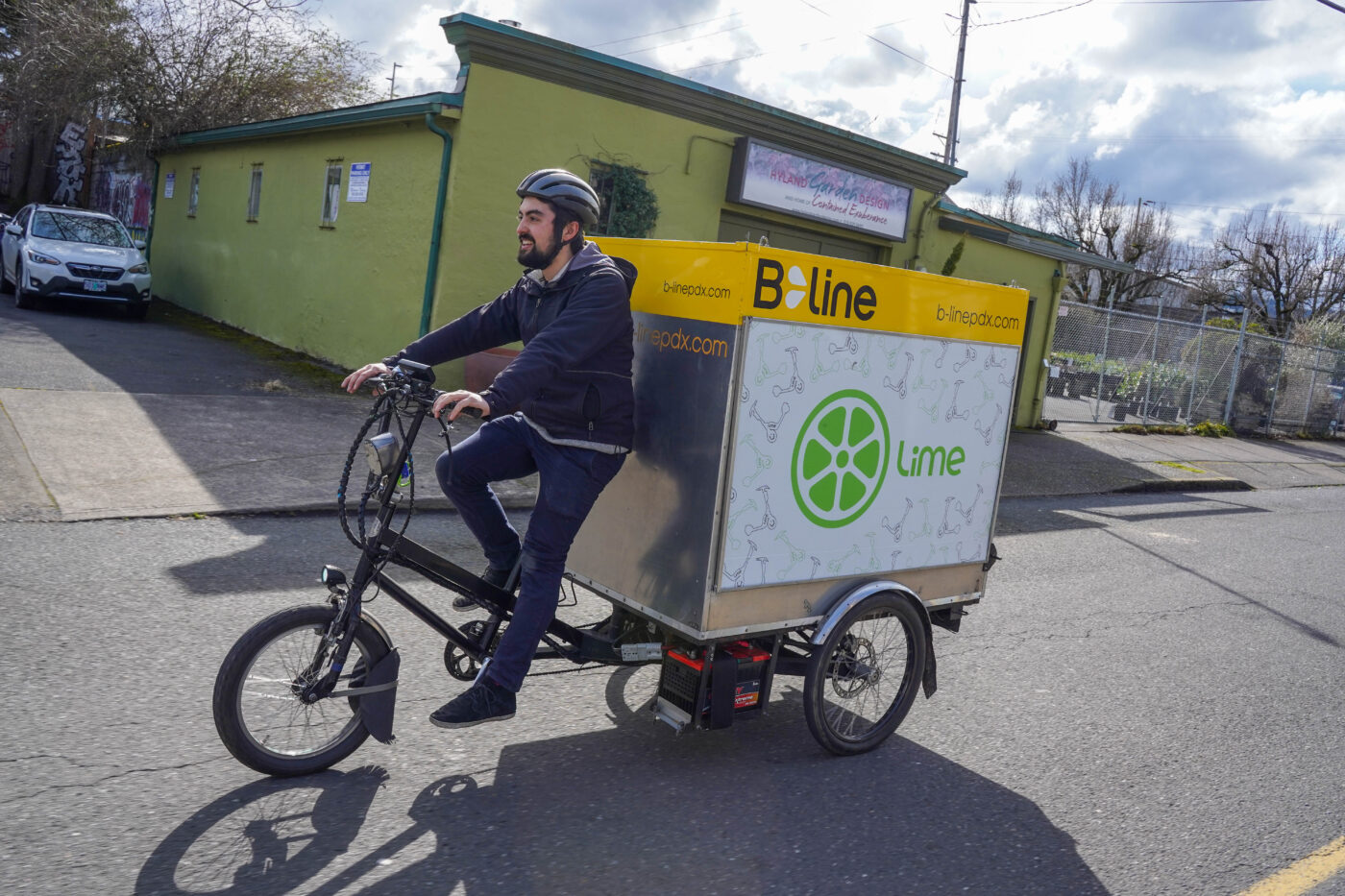
The debate around electric bikes at the Oregon Legislature is heating up ahead of a work session and possible votes on Friday.
As BikePortland reported last week, House Bill 4103 has split opinions among cycling advocates. Now the debate has escalated to a national level as industry group People for Bikes has entered the fray.
PFB has written a letter to leaders of the Joint Committee on Transportation urging lawmakers to make several key changes to the bill. The letter, dated Wednesday 2/21, was written by PFB’s Electric Bicycle Policy & Campaign Director Ash Lovell, Ph.D. The letter had been co-signed by Portland-based nonprofits The Street Trust, BikeLoud PDX and No More Freeways. National bike advocacy group the League of American Bicyclists has also signed on.
The letter says Oregon is at risk of falling out of alignment with federal regulations if the bill does not include language in its definition of “electric bicycle” that clearly stipulates a maximum motor size of 750 watts and the presence of pedals.
Current law allows e-bikes to have a maximum power of 1000 watts, and that size is preferred by cargo bike companies that deliver freight, but PFB says that’s not the industry standard.
“We recognize the desire of commercial interests in Oregon to have the ability to use higher wattage vehicles to transport freight when using electric cargo bicycles. These commercial cargo bikes are not consumer products regulated by the CPSC (Consumer Product Safety Commission), and could have motors in excess of 750 watts,” the letter states.
PFB wants new language that clearly defines e-bikes motors with a maximum of 750 watts and, “an electric assisted bicycle used for commercial purposes to transport cargo,” to have a maximum power output of 1000 watts.
Another suggested amendment is to make sure the definition of an e-bike includes having, “fully operative pedals.” This would disqualify many models that are used more like mopeds or motorcycles from being legally considered electric bicycles.
PFB is also concerned about HB 4103’s language around a ban on people 15 and under from using Class 2 or Class 3 e-bikes (any bike with a throttle), and related traffic violation when they are caught by police.
“This subsection also seems to include underage riders who are merely passengers on either Class 2 or Class 3 bicycles,” Lovell writes in the letter. “This would inadvertently eliminate the ability of families to take advantage of family cargo bicycles that are designed to have children as passengers. Many of these electric bicycles are Class 2 bicycles with a throttle. Family e-cargo bicycles can greatly reduce traffic congestion, air pollution and GHG emissions.”
The final change they request is language that would allow first-time violators of the new “unsafe riding” violation to have the offense waived if they complete a safe riding course.
The bill had a public hearing last week and is slated for a work session and possible vote tomorrow (Friday, 2/22) at 5:00 pm.







Thanks for reading.
BikePortland has served this community with independent community journalism since 2005. We rely on subscriptions from readers like you to survive. Your financial support is vital in keeping this valuable resource alive and well.
Please subscribe today to strengthen and expand our work.
Why not have the new electric micro-mobility task force work out the best legislation?
There is no such thing as “motor size of 750 watts” or a “750 watt motor” An electric motor receives watts from a motor controller and then outputs rpm & torque based on the power delivered to it. They are no designed to only accept x number of watts. The limiting factor becomes overheating, but that means peak watts and continuous watts are very different things and depend on weather and speed etc.
You might think, ok lets limit the motor controllers but they are generally all setup with software and the hardware is over-built so it can put out a lot more power than 750w. You wouldn’t want to be running an electrical system at it’s actual heat limit.
Same with speed, it’s also not something that can be easily relegated at the production side because again it ends up just being a software setting you can change with a button on the bike or an app on your phone.
Thus all five electric bikes I’ve owned can be easily set to exceed 32 mph, and one can go up to 8,000 watts peak, I haven’t measured the others.
I don’t see how they can enforce these kinds of limits since you can easily setup these bikes with bike-legal and off-road modes.
Changing the true top speed of hub motors (i.e., not a software imposed limit) is generally difficult because it’s defined by the supplied voltage and the motor’s windings and internal gearing (as you go faster the back-EMF grows until it reaches that natural limit and you stop going any faster). You can increase your wheel diameter but that’s typically limited by your fork length or the length of your rear stays (it’s also a PITA to relace a hub motor into a larger rim). You can get some increase above the back-EMF limit with field weakening (with an FOC) but that’s pretty limited and a current hog. So basically you need a different battery (with a higher voltage) which is technically doable in the DIY space but it’s still a big cost and not practical or possible on most non-DIY rigs, so probably out of reach for many. In the mid-motor case, you can additionally change your chainrings and sprockets — hopefully that chain stays intact…
Batteries and windings/gearings can be regulated but I don’t see the industry getting a clue anytime soon.
I agree the wattage regulation is kind of silly but I think controllers too can be regulated, at least to some extent. It would be difficult though.
Many hub motors are firmware limited below their engineered output. For example, I have “dongle” that allows assist above 20 mph for my ebikemotion hub by changing output to the controller.
Software (firmware) imposed limits on top speed are standard on commercial ebikes but they range from easy to difficult to circumvent (like with a dongle in your case, menu settings in others, etc.). However, the true top speed of hub motor bikes (including your ebikemotion ebike) is impractical to circumvent.
Yea I’m sure you could design a hub motor to not work well past 20 mph but if you designed it that close to a 20 mph limit then it would also be a lot less efficient at 20 mph. So of course at least the ones I have seem to be happy spinning at up to 38-40 mph. Just seems to be motor controlled limited the ones I have anyway. Many e bikes even advertise them as having an ‘off-road only’ mode which you can easily switch to.
Motor efficiency tends to peak close to the back-EMF limit (e.g., @~90%), so designing the true speed limit to be close to the legal limit is practical, at least for hub motor implementations.
Pedals are probably the single most defining part of a bike.
If it doesn’t have pedals, it’s not a bicycle.
Yea but I’m not sure how useful that definition is for us. You could make a 1000lb electric motorcycle that goes 160 mph with pedals. And don’t we still want to allow scooters?
Seems like the real question is – we have some separated transport infrastructure and we have new vehicles, ebikes, e-scooters, electric one-wheels etc. etc. Hopefully we can all agree that we’d prefer people use these over cars. The question is do we make them blend in with cars or do we let them blend in with bicycles?
Given their size and weight I think they generally should fit in much better with bikes. There can be a speed difference but I think generally they’re max speeds are still much closer to bike speeds than max car speeds. Maybe we simply need to regulate speeding.
Weight would be a reasonable and accurate definition.
E-bikes under 50 lbs in bike facilities, over 50 lbs. ride in the street.
Might be kind of low, I think my lightest two ebikes are a bit over 50 lbs. cargo e bikes are like 150lbs.
Except for e-cargo bikes, which are important car replacement bikes for families.
What about someone with a bakfiet who’s carrying their kid around?
The comments so far are pretty informative about the issues around regulating e bikes. Motor ‘size’ is squishy and power output isn’t something that person can easily figure out on the roadside. Your weight criterion is simple but I can’t agree with it since a utility bike can easily go over 50 pounds before adding a motor, battery, and controller, along with a considerable amount of wiring.
The problem we have is more with how people behave than with physical aspects of their bike. A person can be a jerk on a 27 pound bike, or they can be civil on a 200 pound bike with the potential to apply 1000 watts of assist.
What we’re looking for is some version of ‘don’t be a jerk in the bike lane’.
To me the important characteristic is speed. Vehicles traveling 20mph (not wedded to this number, it’s just an example) do not belong on the sidewalk with pedestrians, or even on a narrower MUP. Maybe they are OK in a separated bike lane, but then why not a car traveling at or below that limit?
I think our concept of “bike lanes” and “car lanes” is breaking down as people adopt so many different vehicles with different characteristics and capabilities.
In the abstract, yes, but context matters here. I’m not sure I’d prefer someone operate a one-wheeler traveling at 30mph riding on a sidewalk or narrow path with me as I’m walking (as happens occasionally). It can be pretty terrifying if they approach (silently) from behind.
If we adopted a lower top speed (hand or pedal throttle), say moving from 20 mph down to 16 mph, the bikes would be lighter and more efficient. With only a fifth reduction in speed that’s reduces kinetic energy by more than a third, so you get much softer collisions along with better stopping distance and situational awareness. There would be much complaining about taking away freedom units and the bike companies (PFB) would lobby hard against it, but it would be safer and go a long way to improve integration with peds and bikes on MUPs.
Shouldn’t we care about the the actual data more than the feelings? How many pedestrians have been killed by bicycles riding on the sidewalks? Compare that to how many bicyclists have been killed riding with cars.
Besides what your saying you car about is the speed they are traveling at not the speed they are capable of. Hence if a bicycle rides slowly on a sidewalk that should be fine despite how fast it could be going.
Personally I’ve even ridden on sidewalks because sorry I’m going to value my life over the letter of the law and sometimes the sidewalks seem far safer in some areas.
It’s legal to ride on sidewalks in Portland except for parts of downtown:
https://www.portland.gov/transportation/walking-biking-transit-safety/bikes-and-law
Not ebikes which I generally ride, as if somehow they are safer to mix with car traffic, it’s ridiculous.
https://oregon.public.law/statutes/ors_814.410
And guess what, actual people who ride don’t care. Only people who like or worship power. If they are on two wheels, that’s good.
Well, I’m an actual person, and I ride, and I don’t feel comfortable with motorcycles riding in the bike lane or on MUPs.
In 20 years this will all be moot. Teens are adopting electric motos at a rapid pace. There is a lot of pearly clutching and hand wringing and the reality is it’s good. Because last I checked it was heavy vehicles (looking at you 6000lb electric “car” (really an suv) that’s killling and suvs too.
But what better way to feel better about driving your kid killing suv than to point at kids riding a 30lb e bike/moto as “it’s so dangerous”! Fine start a program for kids for e motorcycles. Be the first to innovate not the last Oregon.
Is the suggestion that a teen riding an emoto is safer than someone driving an SUV? Or that emotos are going to somehow be safer than traditional motorcycles?
I am concerned about this language. An e-cargo bike that weighs close to 100 lb with a 200 lb adult and one or two 50 lb kids or groceries that needs to go up a hill on a regular basis could easily use that 1000 watt e-assist.
Does this mean that I can’t use a bike lane at 1000 watts unless it is for “commercial” reasons?
I would rather see a max bike lane speeds for e-bikes.
1000 watts is approximately the total amount of power applied by two of the best racing cyclists in the world, not in a sprint but in the critical parts of a race when they work at their highest steady output. It’s two super humans at your disposal for 30-40 pounds of added weight.
An e bike with 350 to 400 watts of output on a mid drive will get an average rider on a 400 pound gross weight bike up most hills in Portland at a good clip. A hill that is too steep for that setup might be best avoided. Handling becomes more of an issue than power output at some point and it sucks to dump the groceries.
I get it that oversized motors can operate at a lower stress and heat level than something smaller that is maxed out. However it seems to me that saying a cargo bike needs 1000 watts arises from the same kind of thinking that got us 300 horsepower passenger cars.
Lots of e bikes are running on wheels, spokes, and drive trains designed for human power. If a person puts a bunch of extra torque on that stuff something is going to give. I’ve had 3 broken spokes in the last six months and I have to start carrying spares. One broken spoke per year would be more typical.
I know that “watts” is only part of the story, but my personal experience is that I break 750 to get up a particular unavoidable hill going 5-8 mph. I also get over 750 a few other spots like NE 7th going to Sandy where I would rather keep a consistent speed of 12-15 mph.
I understand the slippery slope argument here but I think there are natural reasonable limits built in to ebike usage, i.e., the slope of hills the weight of the bikes, the weight of operators. I think that the 1000 for commercial only is somewhat arbitrary and probably doesn’t fully take into account families using e-cargo bikes as a car replacement.
It is self defeating to say to people- you can drive a car and have access to everything without question, but we are going to draw an arbitrary line that puts many common routes or tasks just out of reach.
You can calculate how many watts it takes to go up a grade with a weight and desired speed. 1000 watts for 250 lbs on a 30% grade is only ~6 mph.
Seems kind of silly to worry so much about the power output and safety if we want to encourage less cars. I mean we already know normal pedal bikes are far more dangerous per mile than cars by like 10x, mainly because of the risk of being hit by said cars.
When it comes to bicycles and safety risk your mainly risking yourself riding a bike over a car, so why not let people?
This comment will likely not be published due to censorship.
It’s sad how rapidly electric motorcycles have infiltrated our formerly human-powered spaces.
Is that something that land managers could help out with?
A few radioactive topics aside, there is no censorship here.
You might be surprised to find out the truth.
What’s sad about it? It would be more helpful if you could point to specific problems that e-cycles create.
For me it’s all about speed and weight, which determine the potential of e-cycles to harm other users. While I was riding my bike on the Springwater, a guy on an e-bike close-passed me from behind at must have been 30-35 mph. It was really unnerving, and at that speed, he could kill other users. That’s the kind of behavior that needs to be regulated, not the equipment.
It’s funny that e-bikes need their power to be limited, while there is NO commensurate limits on cars, trucks, or SUVs. A Mustang or BMW can easily cruise at 120mph, which isn’t allowed on any road. Why is that?
What’s sad is we have a new much more environmentally friendly form of transportation, but it has 10x the fatality rate of driving. Yet many people seem keen to make it even more dangerous not less.
Given that all the data I’ve seen seems to show the main cause of ebike fatalities is the rider being hit by a car, don’t you think it’s better to let them ride away from cars and share the bike infrastructure so that we get less fatalities?
With all the technological nuance and variability of “e-bike “ configuration it is reassuring that Oregon’s legislators are informed and sophisticated
/s